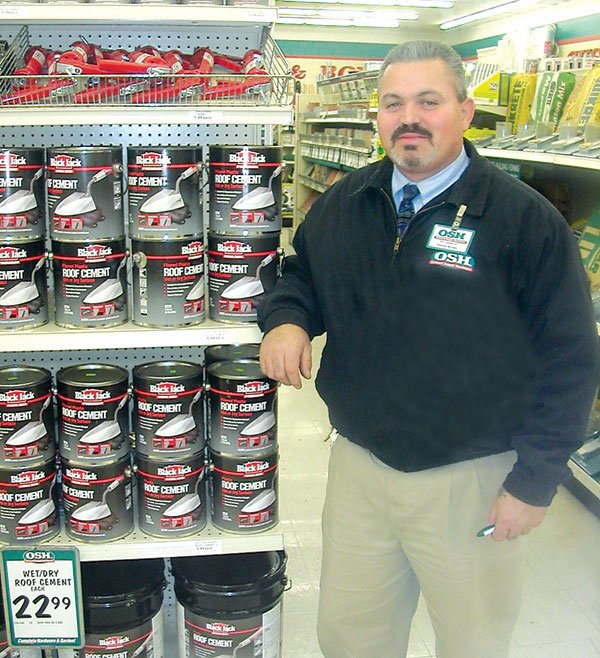GILROY
– As customers race into the store and buy up rainboots,
jackets, tarps and roof cement, Art Camacho can only shake his
head.
GILROY – As customers race into the store and buy up rainboots, jackets, tarps and roof cement, Art Camacho can only shake his head.
“Honestly, they always wait until it rains,” the Orchard Supply Hardware assistant manager said. “I’ve been doing this for 12 years, and I always say ‘Why? It’s too late. It’s been raining for four hours.’ ”
Orchard, like most home-improvement stores in the South Valley, is prepared for the onslaught of homeowners who race over in the pouring rain to buy anything and everything in sight to try and stop the surging waters from doing damage to their homes.
“We set up for this,” he said. “We get it all out front right here in the main aisle.”
Orchard already is showing signs that people waited to long to do basic maintenance on their homes. Nearly the whole stock of rainboots in adult men’s sizes have disappeared off the shelves along with countless cans of roof cement and gutter seam caulking.
But Camacho, as he tells people every year, is still trying to let people know what may seem obvious only to him: Fix your gutters before the rain comes.
“Now that it’s stopped raining, go in and fix it,” he said. “If you know it’s going to be clear for a few days, it’s time to fix those parts you forgot.”
Many residents got a pretty good idea whether their storm drains were in good shape during the heavy rains that hit the Bay Area on New Year’s Day, but Camacho said that the biggest rains of the season come in the late winter and spring, so residents should use this early storm as a way to see how their gutter system is holding up rather than lose a lot of money in the long run.
“It costs less to do preventative work compared to a quick fix after the fact,” he said. “You’ll have to pay afterward. You’re looking at about $10 to $25 now compared to if you wait, you’re looking from $100 to more than $1,000.”
Checking the gutters
While it may seem like a burden to haul out the ladder and take a peek to see just what made its way into your gutters in the last year, Camacho said it’s something that simply needs to get done.
“All you’re doing is taking a half-hour to check it out,” he said.
Camacho said the best way to check the gutter system is by spraying water down the drain by using a garden hose. By running the water, it is easy to spot leaks and find whether there is a back up in the system.
“You should test the gutter yourself with a water hose,” he said.
Camacho said it’s important to clear any leaves and to consider placing gutter guards where leaf buildup is heavy. Sediments that build up on the roof and in the gutters also can become a problem when the first rains come.
“It acts like a sap,” he said. “It’s like gum in your gutter hole.”
There’s an obstruction in the gutter if the water backs up and starts coming out over the top. Also, it’s important to fix any leaks in the system so water doesn’t soak through and rot the side of the house.
And it’s also important to see just where the water is going one it leaves the gutter system.
“At the spout, what is it doing?” he asked. “Is it soaking up or is there runoff?”
If the water is starting to pool up, Camacho said to look at ways to divert the water away.
Standing water
When a resident sees an area in the yard that is holding standing water, they often think they’ve found the problem. But Camacho said it’s more important to find out how the water pooled up their to begin with to avoid long-term problems.
“The first thing you want to do is identify where it is coming from,” he said.”That’s where the real problem is. The puddle is going to be there, but you need to know where it starts.”
From there, Camacho said that by extending the drain pipe off the house can help to alleviated the problem and keep the water from washing away gardens or causing foundation problems.
“Try to get it constructed so it’s going downhill, not toward your neighbor’s house, but to a storm drain.”
Camacho also warned to make sure residents know how much dirt and other items are flowing into the storm drain. While it may not appear to be a problem, it can back up in the sewer system and flood the street.
Standing water can create big and costly problems if it isn’t taken care of quickly. Camacho said if the water isn’t taken care of, it can cause the foundation of the house to shift.
“(The ground) soaks more water up than it can handle, and that causes the foundation to shift,”he said.
Washing away the dirt
With torrential rains like occurred Jan. 1, even drainage systems can be overloaded in near flood conditions just due to the amount of rain falling. The large amount of running water can wash dirt away from around the hours and in garden areas.
Camacho said that some dirt areas can be saved by adding sand to the soil.
“Try to mix some sand in there because it sucks more of the rain up,” he said.















